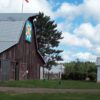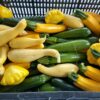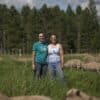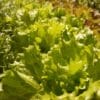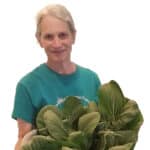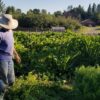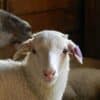Hands to Help our Wild Friends

Winter can force us to face the suffering that surrounds us. The cold bites our faces, our dogs hop on three or two legs, aging loved ones struggle and pass on. We can swing through spring and summer infused with a sense of bliss, but winter holds a pitiless side that reminds us of our own mortality and pain that all living beings endure.
The reality of this situation can crush us or fuel our resolve to be a force of goodness amidst the suffering. While I’ve certainly been a member of both camps, my practice is to choose the latter and be an agent of inspiration, empowerment, and renewal. Writing these weekly articles is part of that practice. This week, I added a new initiative to my list, which I want to share with you.
Half a world away in Australia, fires rage, destroying habitat and a conservative estimate of one billion animals. My heart cried for the suffering. Fire is the LAST thing I would ever want to experience on our farm. The suffering of the animals (both wild and domestic) that appeared in social media broke my heart because they do not have the same options to flee as people do, and often they are too scared to make the best choices and therefore perish or suffer unspeakable fear and pain.
Of course, I can’t simply abandon the 1500 or so animals in my own care here on the farm to run off to Australia. I’m not a firefighter. What could I do? Then I received a message from Emily Moe (my millinery instructor from 2018 at the folk school in Grand Marais), urging me to join American Rescue Crafters, which is a national group that works directly with wildlife rehabilitators to support them with sewn, knitted, and crocheted items that facilitate healing and a sense of safety for injured and ill animals of all kinds—from bat wraps to wallaby pouches to nests.
Of course, the big push was to make and send items to Australia. Each week they posted a needs chart, with items marked in red having the greatest need, yellow moderate need, green less need, etc. Nests were marked red, so I clicked through the files database of approved patterns and printed my own copy to get started. Nests—how perfect for me as a crochet artist. I love birds, and in Australia it’s summertime, where many birds will have lost their homes in the fires.
But just as I finished my first set of nests, the social media group was scrambling in the wake of so many donations from over 50K members. “Please stop sending items to Australia, we are flooded!” came the urgent plea. They needed time to organize and distribute, and they did not want donations to go to waste. “Please contact your local centers to see if there is need for items you have made,” was another suggestion from the harried coordinators.
Of course, I thought, how classic that an international crisis would rally the efforts of so many, but the close-to-home caregivers who don’t make the headlines are left struggling. This was a moment of “think global, act local.” A global need brought a workable solution to my attention, but now it was time to turn that attention to the region where I live. Wildlife suffers in Wisconsin’s Northwoods as well. Now, where to turn?
I reached out to naturalist Emily Stone from the Cable Natural History Museum. Immediately, she pointed me to the Northwoods Wildlife Center in Minoqua, Wisconsin and the Wildlife Rehabilitation Center of Minnesota in Roseville. I picked up the phone and started calling, explaining this project, what I was making, and the suggestion to reach out to local center to see if they would have need for these items. Both were quite interested in the nests. Not that they need them immediately because we’re in wintertime, but certainly they would be helpful by spring.
“That would be perfect for our songbird nursery,” the receptionist at the Minnesota Center agreed. “We’d take 30 to start with, and if those work out great and we need more, we’ll be in touch for a second batch.”
So now I have a goal: 60 nests by spring. And I also have a place to send them: two locations which could have been easily overlooked for receiving these donations. As a fiber artist, it feels good to use these handcraft skills to make something that gives back to the community. And as a bird lover, it seems especially apt. I treasure the songbirds of the Northwoods, and I yearn to ease suffering when I can.
And you can too, if this story makes you feel motivated to join the rescue crafters movement. I will be adding a post to my studio website www.erindaletapestrystudio.com with links to the pattern for the nests, contact info for the rehabilitation centers, notes on best yarn choices, and ways to connect with the rescue crafters network. You can make nests too! Or, if you don’t have time but have a yarn stash you would like to donate towards making nests, that’s a great way to engage too.
Our hands can be agents of suffering or agents of healing. These hands are ready to help our wild friends. This week, think about what your hands can do to inspire, empower, and renew the pieces of this earth that you touch? See you down on the farm sometime.
Nest Pattern Rewrite
Size H 8 crochet hook
This pattern is worked as a spiral. A stitch market is helpful for knowing where each round ends/starts. Acrylics are preferred since they are easy to wash over and over.
SC=single crochet
ST=stitch
SLST=slip stitch
BLO=back loop only
Circular Base (make as wide as necessary for the size nest you want to create. This is written out for the largest nest, but you can stop at any round and jump to making the sides)
Working two yarns together, make a Magic Circle
Round 1: work 6 SC into Magic Circle, pull tight.
Round 2: work 2 SC into each ST of last round (12 SCs)
Round 3: *SC in next ST, work 2 SCs into next ST, SC in next ST; repeat from * 6 times around (18 SCs).
Round 4: SC in next ST, *work 2 SCs into next ST, SC in next 2 STs; repeat from * 5 times, ending with a more SC (24 SCs).
Round 5: *SC in next 3 STs, work 2 SCs in next ST; repeat from * 6 times (30 SCs).
Round 6: SC next 2 STs, *work 2 SCs into next ST, SC in next 4 STs; repeat from * 5 times, ending with 2 more SCs (36 STs).
Round 7: *SC next 5 STs, work 2 SCs into next ST; repeat from * 6 times (42 SCs).
Round 8: SC next 3 STs, *work 2 SCs into next ST, SC next 6 STs; repeat from * 5 times, ending with 3 more SCs (48 SCs).
Round 9: *SC next 7 STs, work 2 SCs into next ST; repeat from * 6 times (54 SCs).
Round 10: SC next 4 STs, *work 2 SCs into next ST, SC next 8 STs; repeat from * 5 times, ending with 4 more SCs (60 SCs).
Round 11: *SC next 9 STs, work 2 SCs into next ST; repeat from * 6 times (66 SCs).
Round 12: SC next 5 STs, *work 2 SCs into next ST, SC next 10 STs; repeat from *around 5 times, ending with 5 more SCs (72 SCs).
Creating the Sides (these will feel long, but remember that they are folded over in half towards the outside to create stronger sides)
Transition Round: working BLO (this round only), SC in each ST around—this will help draw the sides up.
Continuous Round: SC in each ST around to desired height.
Sizing Chart: (in inches)
Base Round # Diameter of Base Height of Sides (unfolded)
3 1.75 1.25
4 2.25 3
5 2.75 3.25
6 3.5 3.5
7 4 3.75
8 4.25 4.25
9 5.25 4.5
10 5.75 5
11 6.5 5.25
12 7 5.75
Finishing
SLST around the top of the sides, bind off. Bury tails. Fold down sides to create your nest!
